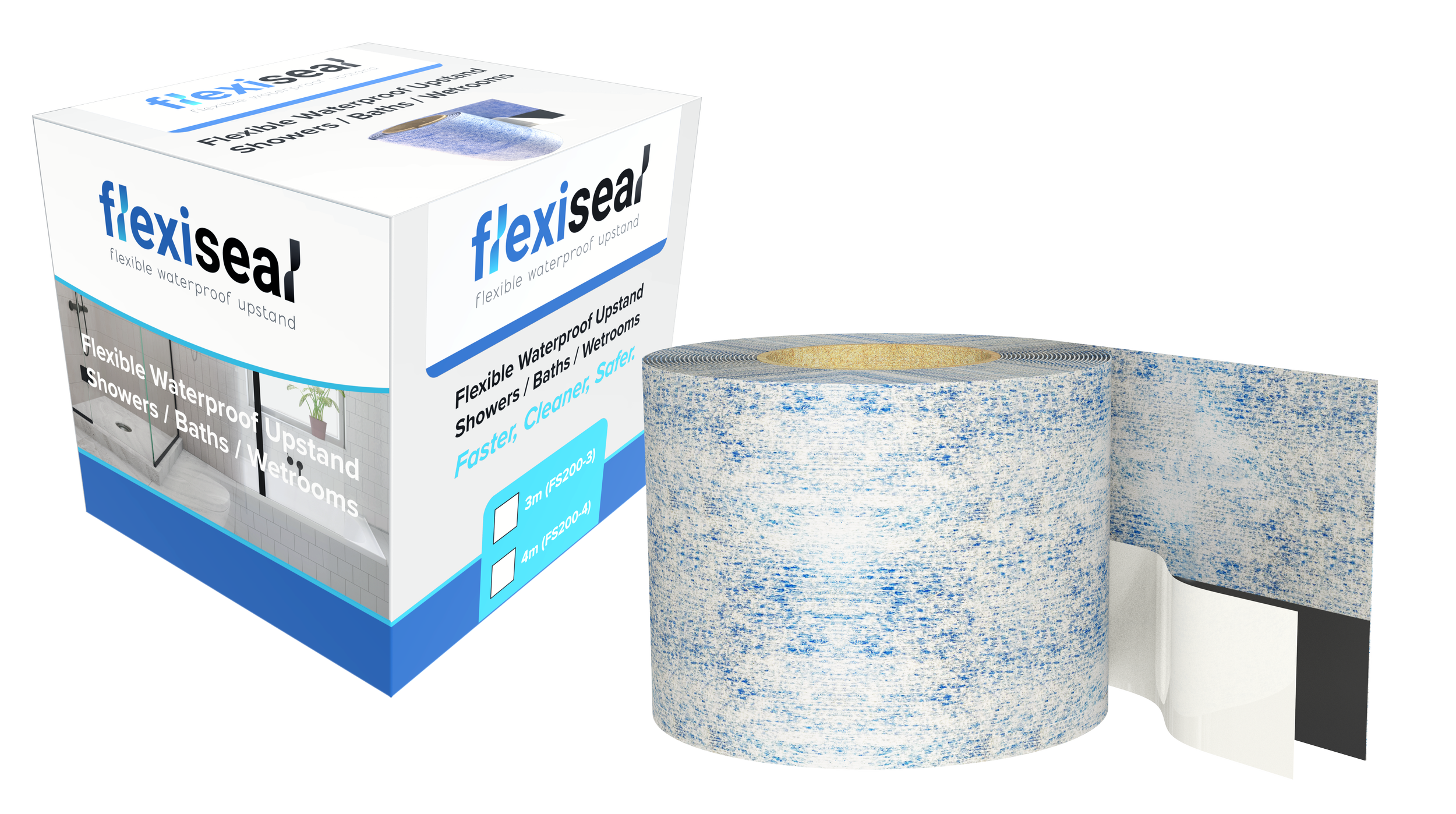
Flexi-Seal Waterproof Flexible Upstand
With multiple innovation awards, Flexi-Seal is a professionally recognized, tested, and proven waterproofing solution applied by hand to the wall-facing sides of shower trays or baths prior to installation. The inherent flexibility of the product can accommodate 15mm of movement, making it equally suitable for new builds, repairs, or renovations. Flexi-Seal consists of a flexible, waterproof, fleece-backed, tenacious upstand material with a pressure-sensitive (PSA) copolymer isobutylene and isoprene butyl rubber adhesive. It effectively prevents water leakage around shower trays and baths caused by inevitable shrinkage and movement within buildings. This material is extruded with an integral anti-stretch glass fiber reinforcing strip, aiding speed and ease of fitting while also allowing for subsequent manipulation in the corners to assist with tiling and wall linings. Flexi-Seal is supplied in a range of lengths to match standard shower tray and bath sizes and is used in an unbroken, continuous run.
| Supplier Code | Description | Length | Quantity per Box |
|---|---|---|---|
| FS200-3 | Flexi-Seal Upstand | 3 metre roll | 1 |
| FS200-4 | Flexi-Seal Upstand | 4 metre roll | 1 |
Resources
Resources
Key Features
Accommodate up to 15mm of movement
Prevents leakage around showers and baths.
Install in as little as 5 minutes.
Supplied in 3m (FS200-3) and 4m (FS200-4) lengths.
FLEXI-SEAL IN ACTION
Flexi-Seal acts as a secondary seal between the ledge of the shower tray or bath and the wall. It prevents leaks around horizontal surface to wall transitions where cracks and leaks have always been a troublesome area from shrinkage and movement of buildings.
The FlexiSeal upstand has a flexible but fleeced outer reinforced material to work and adhere tenaciously with tile adhesives, silicone adhesives, wall liner adhesives and waterproofing liquid membranes. It adheres to the bath or shower tray with an aggressive butyl pressure sensitive adhesive bond.
The upstand is 120mm tall so it safely covers a wide surface area up the wall to fail proof this critical joint while remaining flexible enough to bridge and allow for expansion and contraction of the transition. With a tough fleeced backing and incredible strength, it’s even ideal for small format mosaics or subway tiles.
STEP 1
Thoroughly roughen and clean the sides of the tray or bath the Flexi-Seal is to be applied too.
STEP 2
Remove the backing paper 100mm at a time. Align the top of the adhesive strip with the top edge of the shower tray or bath and firmly press on by hand.
STEP 3
Manipulate and “pinch” to widen and square the upstand at the corners. The Upstand is easy to manipulate by hand to fit into irregular internal corners which are not square, so as not to interfere with the tiling, or wall lining. Dry fit and position the tray or bath in position.
STEP 4
After dry fitting, install the tray or bath. Fold down the Flexi-Seal and apply with tile adhesive , waterproofing liquid membrane or silicone sealant pattern to evenly adhere the Flexi-Seal to the wall. Use a trowel or flat spatula to smooth out the Flexi-Seal so it adheres neatly & smoothly to the wall surface. Waterproofing, lining and tiling can begin as soon as your selected adhesive has cured.
THE PROBLEM?
The most susceptible area to leaks is the joint between the shower tray, bath rims and the wall tiles or wall liner. For obvious reasons, waterproofing systems are necessary for ‘tanking’ in wet areas, but the fail-proof system for sealing around baths and shower tray ledges along walls has largely been unresolved…..until now!
WHAT & WHY IS THIS HAPPENING?
This crucial bath/shower tray & wall connection is exposed to movement from, frame shrinkage, load settlement, high moisture and thermal fluctuations, expansion and contraction at different rates creating stress at these critical joints. If provision is not made for this, movement, stresses, cracking, and voids can occur, as well as capillary action of water & moisture. Under the additional load of water in baths and the weight of occupants on shower trays along with hot and cold temperatures, this wall & edge joint is susceptible to movement and thus needs the flexibility to resist cracking & detrimental results of failure over time. •
Buildings move – solid fixings crack, silicone joints, acrylic wall liners & trays warp or debond from silicone seals.
Bathrooms are always changing from hot and cold - Room & climate changes cause expansion and contraction
Steam & moisture, flooding, poor caulking/silicone sealing allowing capillary action into wall cavities
THE SOLUTION!
WHAT IS FLEXISEAL AND WHY IS IT NEEDED?
FlexiSeal is a time-tested, proven flexible upstand system that connects the shower or bath to the adjoining wall, acting as a “sealant and bridge” to provide a waterproof yet flexible connection between these two troublesome areas. Without a flexible upstand transition connecting this perpendicular joint, a reliable waterproof seal cannot be achieved, leading to potential leakage over time. FlexiSeal is made from a CIS fleeced material that features tenacious adhesion along with a pressure-sensitive butyl adhesive, allowing for a waterproof seal while still accommodating movement.
HOW DOES FLEXISEAL FIX THIS?
FlexiSeal is specifically designed to tenaciously adhere to various materials on walls, baths, or shower trays. Its flexibility allows it to bridge troublesome areas, accommodating joint movements without cracking! While silicone sealant is commonly used around baths and shower trays, it has limited ability to stretch between the wall and edge. Often, it does not adhere correctly (for instance, it may not be the right type of silicone for the surfaces being joined), nor does it endure harsh conditions over time. This can lead to de-bonding, tearing, and ultimately leaks.
This new and improved practice is promoted by sealant manufacturers and building standard bodies worldwide, having been tested and proven to stand the test of time. Sealant flexibility is referred to as the “Movement Accommodation Factor” (MAF) or CLASS, and is generally measured as a percentage of extensibility and compressibility when the sealant is cured and at rest. A sealant with an MAF of ±25% (CLASS 25 sealants) can extend or compress by 25%. To accommodate a 2mm wall/ledge joint expansion after installation, you actually need a minimum unobstructed sealant "bridge" of 8mm.
This 8mm "bridge" represents the hidden face of the sealant, and an additional 4mm depth is required to bridge the wall and ledge, resulting in a substantial exposed face. Large surfaces and exposed sealant areas in the shower and bath environment tend to attract waste matter, forming an unsightly and unhygienic film that accelerates deterioration. Cleaning the sealant can often lead to tearing or de-bonding from the wall or ledge surface, especially if the seals are already in poor condition.
Many installers are prompted by aesthetic and hygiene concerns to minimize sealant visibility, which can impact the sealant's capacity to stretch and accommodate joint movement, often leading to splitting or de-bonding and eventually causing leaks. Therefore, a reliable, proven, fully waterproof transition beneath these final silicone joints is imperative.















